Mongol Conquest 1200-1300
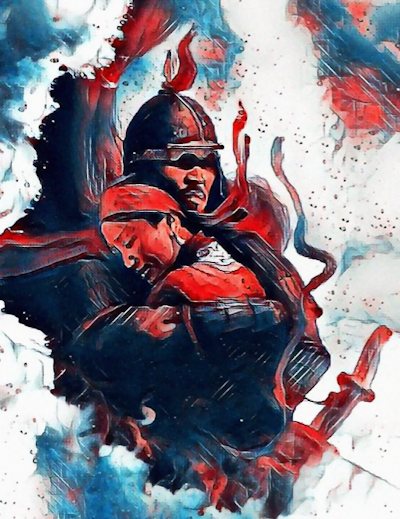
Whenever a brutal invasion is touched upon it is the Mongol conquest that springs to mind as the epitome of medieval scourges of humanity. It is no surprise that the Dothraki tribe in Game of Thrones ➚ is modeled on the Mongols. The Dothraki leader is named ‘khal’, a clear nod to ‘khan’ used in Mongolia. Just as the Dothraki were considered an unstoppable war machine in Essos and Westeros so were the Mongols in Asia. The customs of the Klingons ➚ in Star Trek is also based on Mongolian warrior culture.
The speed and ferocity of the conquest is unparalleled, they represent the most terrifying danger the world had ever seen. Whole peoples and their cultures were annihilated. About 25 million people died (same as World War 1 but when there was a much lower world population). The cavalry tactics deployed influenced armies right up until World War 2 when both General Rommel ➚ and General Patten ➚ studied their campaigns. Their strategy and tactics were also used by Napoleon ➚ and nearly every cavalry corps. Only the British Empire surpassed the Mongol Empire in extent and like the British Empire the conquest was short-lived. What made the Mongols agile and invulnerable was that they were nomads with no permanent settlements. No enemy could defeat them by attacking their home towns and cities - there were none to attack.
This page gives the background to the Mongol conquest, including a biography of Temuchin (Genghis Khan) and shows the pattern of conquests in a series of maps. It was in China that the trajectory of Mongol history was decided and China proved the most valuable and toughest conquest. [1]
With all the importance given to such a short-lived empire you would expect the history to be well established and yet there are many little-known facts to share including:
- Genghis's mother was a Christian and he was the adopted son of a Christian king.
- Genghis was defeated in some early battles - he was not invincible.
- Genghis murdered his own half-brother.
- Genghis did not conquer all of China; it was his grandson Kublai who completed the task.
- Nothing is known about his life for the period 1187-95.
- Much of the territory was not conquered by Genghis butby his descendents.
- The homeland of the Mongols was not in the flat plains of the Gobi desert but in an area of mountains and rivers in the far north-east of Mongolia.
- Genghis was buried with little pomp in an unmarked grave near his birthplace. It has never been found.
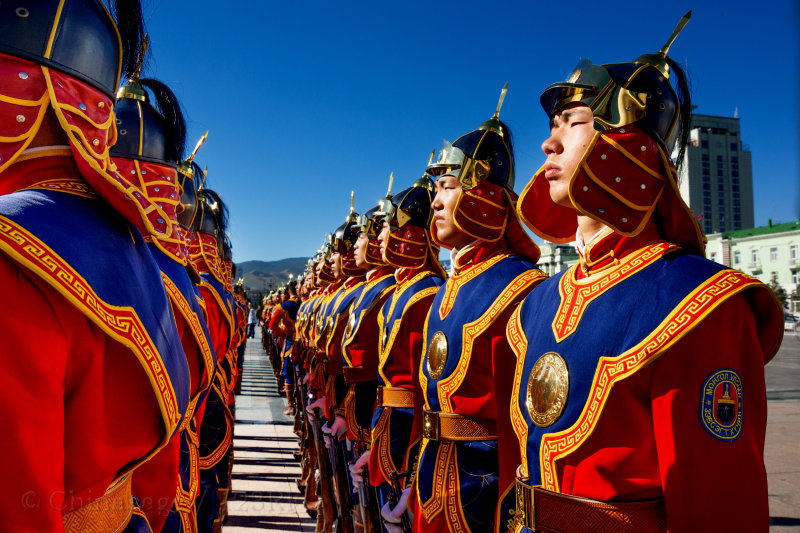
Eastern Asia in 1150
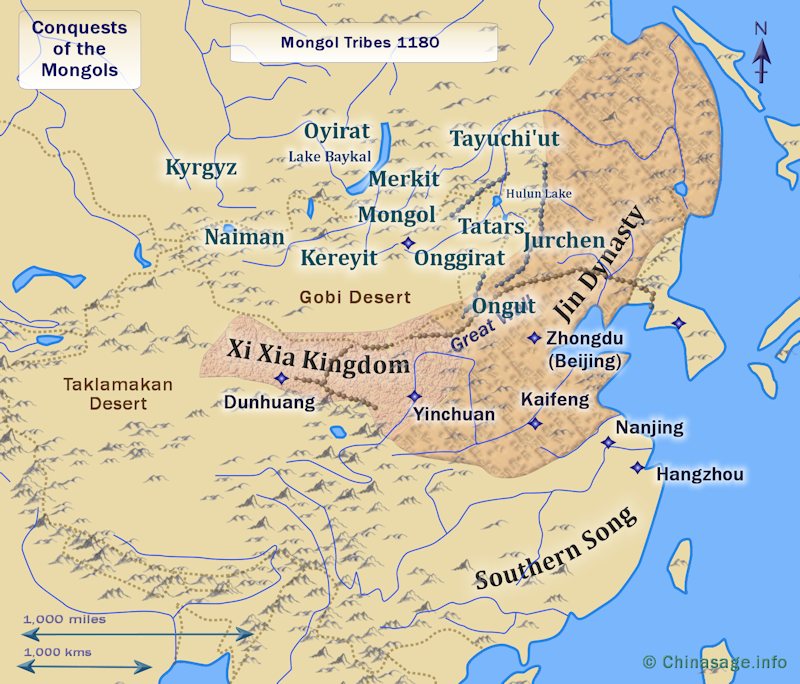
Map of the states in eastern Asia at the time of Genghis's early years. Modern country borders are shown with brown dotted lines. The tribes of Mongolia had boundaries that ebbed and flowed over time as they were nomadic. The Mongols inhabited the central area to the south of Lake Baikul ➚.
The tribes to the north of China had caused trouble for the settled citizens for over a thousand years. The great Qin Emperor built his Great Wall to try to settle the problem once and for all. This had had some effect in stopping small lightning raids across the border. Previously the horsemen would have just sped into settlements and taken anything they wanted before returning north. However the Great Wall had fallen into disrepair over the centuries and was not a serious obstacle to a large, organized force.
After the end of the Tang dynasty in 907 China had fallen into disarray with many rival kingdoms. In northern China this was the time of the Five Dynasties where short-lived military leaders grabbed control only to rapidly fall. Following the unification under the Song dynasty things settled down briefly but northern China was over-run by peoples from the north-east. First there was the Liao dynasty of the Khitan (Qidan) people who were then over-run by the Jin dynasty of the Jurchen people. The Liao had present day Beijing as their southern capital and Datong as their western capital. The Jin dynasty soon took to Chinese ways and it was often hard to see the differences between them and the Southern Song. Meanwhile the Tangut/Tibetan people in the north-west overran the end point of the Silk Road (Ningxia/Gansu) area to form the Xi Xia (Western Xia) kingdom.
It may come as a surprise that some of the Mongol tribes (most notably the Naiman) had adopted Christianity as their religion. This was Nestorian Christianity that had reached China in the 7th century and had become widely established in the north.
Genghis Khan's early life 1162-1187
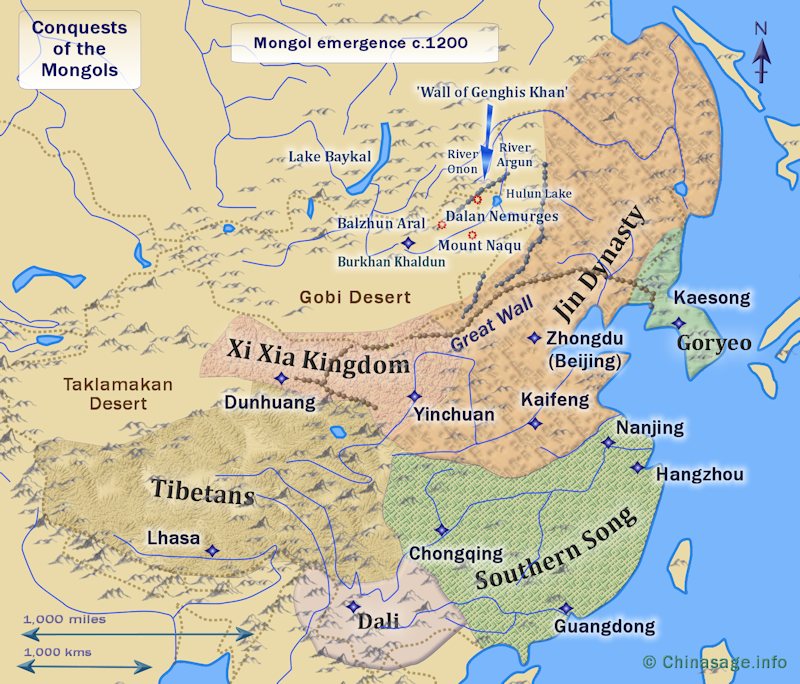
Map of the southern kingdoms 1206-19 including the battle sites close to Temuchin (Genghis)'s homeland at Burkham Khaldum.
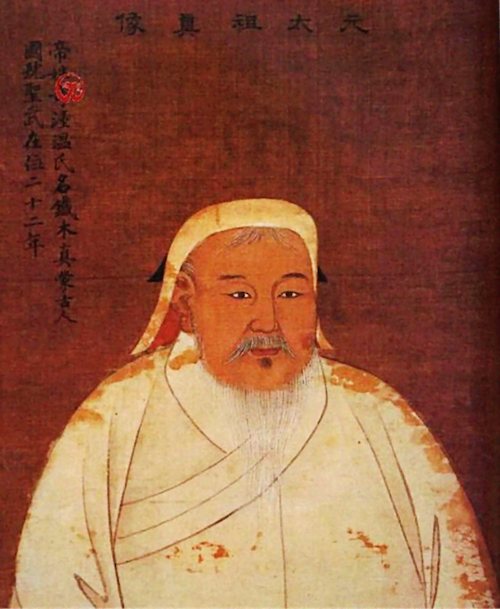
Genghis (or Djingis or Genghiz or Chinggis [2]) was born as Temüjin (or Temuchin) in around 1167 probably at Burkhan Khaldun, to the east of Ulanbator ➚ the modern Mongolian capital that lies at the center of present day Outer Mongolia. It is 730 miles [1,175 kms] from Beijing as the crow flies. Burkhan Khaldun is on the watershed between the rivers flowing north to Lake Baykal (Baikal) and beyond, with the rivers Onon and Argun heading north-west to join the Heilongjiang river that forms China’s present north-eastern border with Russia. Burkhan Khaldun marks not only his birthplace but also his presumed grave.
He was born into a minor clan that squabbled incessantly with the other local tribes. He was a descendent of Khabul Khan ➚ who was Great Khan for a while. Any chance of advancement was by making alliances with neighboring tribes usually sealed by marriage. Genghiz’s mother was of the Ongirrat clan and Genghiz was married to Börte (Bortei) ➚ daughter of the Ongirrat chief when aged just ten in 1182. Borte is described as a strong character who was later influential in deciding strategy and tactics. The Ongirrats inhabited land to the south-east – running to the present China-Mongolia border.
Genghis had another important connection; he had become the adopted son of the leader of the Christian Kerait ➚ tribe as acknowledgment of a debt to Temujin's father. The Mongols were related to the Korean royal family and formed an alliance with them. Genghiz lived through hard times as a boy. After his father was murdered when he was aged 12, the family was destitute and had to subsist on wild plants and eat the occasional mouse. His wife, Börte, was then captured by the Merkit tribe and so he had to tolerate her forced ‘marriage’ to a Merkit prince.
In 1185 he was elected khan (leader) of the Borjigid clan. He divided his fighting forces into archers on horseback and heavy cavalry. Under his leadership an elite squad was formed in two divisions. In 1186 he became rivals with his boyhood blood-brother (‘Anda’) Jumukha ➚ as to who should become overall Mongol ‘Great’ khan. This culminated in the battle at Dalan Balzhut (‘Seventy marshes’) in 1187. Jumukha had gathered a force of 30,000 horsemen from 16 tribes, Temujin was convincingly defeated and he fled into the northern snows to be lost in obscurity.
Genghis Khan's lost years 1187-1195
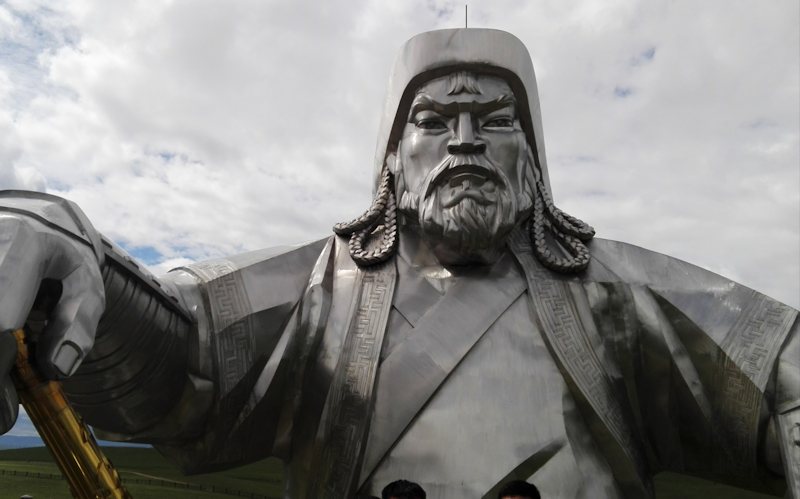
The people of the steppe were an illiterate people and there are no contemporary records of Temujin (Genghis)’s early life (I'll use the name Temujin for him rather than Genghis). The sole record is ‘The secret life of the Mongols ➚’ which was written for his descendents after his death; and so it gives a rather favorable gloss to his life. The eight years after his heavy defeat at the battle of Dalan Balzhut is a matter for conjecture as it not mentioned in the book. What could he have been doing that required it to be expunged from the record?
The most likely explanation is that he was forced to work as a mercenary or servant to some lord. On his re-emergence in 1195 he immediately seems to have advanced military tactics and a canny intuition on how to handle people. Some have suggested that he was forced to serve in the Chinese Jin army against the Tatars. By working in such a trained military unit he would have acquired many skills that would serve him well later on.
At this time the Jin dynasty were working on their own ‘Great Wall’ like the Chinese one to keep the Mongols out. These clear signs of Jin dynasty activity against Mongolian homelands spurred the Mongols, and Genghis in particular, to build a stronger military force.
Mongolian unification 1195-1206 : The Great Khan

Temujin emerged from the lost years with new ideas and great determination. He had a vision that propelled him to seek to bring all of humanity under one unified kingdom. Together with Qin Shihuangdi, Zhu Yuanzhang and Mao Zedong, the Mongol Emperor Genghis Khan is one of the few men to individually influence the shape of modern China. To begin with he had some old scores to settle, but his small army was greatly outnumbered.
First on the list were the Tatars ➚, in 1196 Genghis allied himself with the Keraits led by Toghrul against them. The Keraits were allied with the Jin dynasty - who played Mongol tribes off against each other in an enduring divide and conquer strategy. The Jin made the fatal mistake of treated Temujin discourteously. At the Battle of Dalan- Nemurges he defeated the Tatars. However his old enemy Jumukha united with Senggum of the Kerait tribe against him. At the Battle of Kalakalzhit ➚, 1202, Temujin was outnumbered ten to one and was defeated, he retreated to Balzhun Aral. However his comeback was swift, in 1203 he defeated the Kerait king (Wang khan) and Temujin became king in his place.
Next on the list were the Naiman tribe. In the summer of 1204 he launched an attack on the Naimans who had allied with his old enemy Jumukha. The battle near Mount Naqu showed Temujin's new skills. It was a carefully planned attack. Messengers kept Temujin appraised of the situation on the battlefield as it unfolded so he could direct the attacks. This was a move away from an uncontrolled melée which had been the Mongol mode of combat. Temujin won the battle comprehensively, with Jamukha fleeing and many of the Naiman slaughtered. Jamukha was eventually captured by his own people and executed in 1205.
So it was that with all local opposition defeated that Temujin was elected ‘Great Khan’ aged 39 in 1206 at the sacred mountain close to the source of the river Onon ➚. He then took the title ‘Genghis’ which means ‘Oceanic’ or ‘Blue’ to proclaim himself ‘Lord of the Four Seas’ (meaning the whole world). The Mongolians also gave him the Chinese title ‘Emperor Taizu’ 太祖. He believed he now had the right to treat everyone in the world as his subjects.
The Mongol war machine
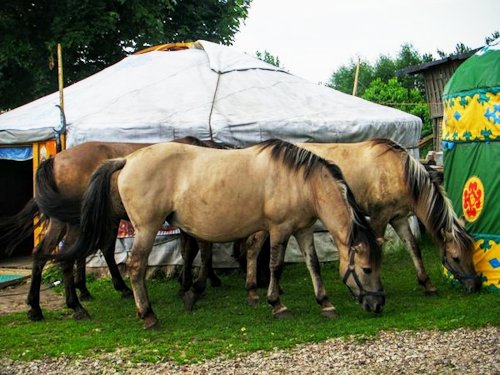
The life of the Mongol people was so different to ours that it requires description. Mongol life was dominated by horses. The need to continually move horses to fresh pasture prevented any permanent settlement. Their felt covered huts are called yurts (or ‘gers’ in Mongolian); these could be quickly built and light enough to be carried by horse. Their attachment to open land was hard to dislodge. Some later Mongolian emperors preferred to sleep in tents in the palace grounds rather than within the palace buildings.
As there was no infantry the whole army could move swiftly. The word ‘horde’ is one of the few of Mongolian words in the English language derived from ‘orda’ or ‘ordo’ for military camp and is also the origin of the ‘Ordos region ➚’ of Inner Mongolia.
Horses provided transport but also food, not only in the form of meat but also as mare's milk and even blood. Mongols became adept of draining horse's blood as a nourishing food always readily to hand. A large group of unmounted horses were herded in the rearguard to replace tired or injured horses.
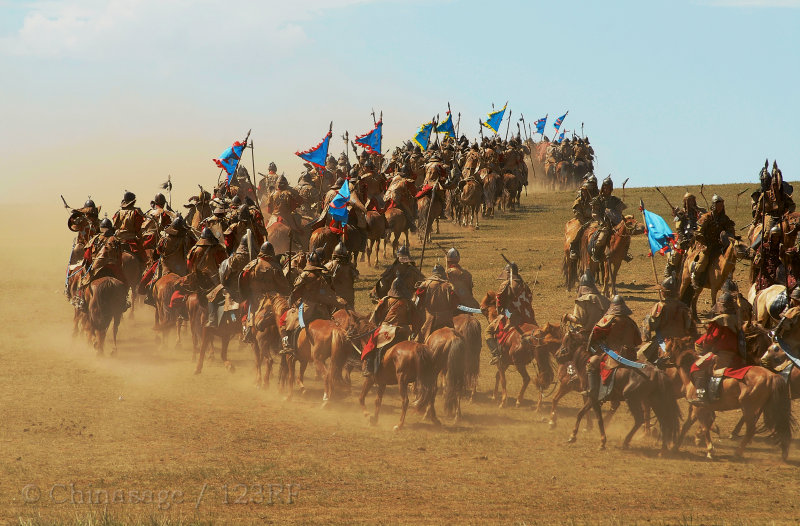
Mongol culture grew to be competitive and combative. Mongol children were very soon on horseback and stretching bowstrings. Soon they would gain the skill of hitting targets accurately from horseback. Women were responsible for setting up the yurts but were also skilled with the bow. The horsemanship and archery skills made them a formidable force. The chief pleasure was in hunting animals, in those days, tigers, elephants as well as deer still roamed the steppes and provided the most popular sport. Military service was compulsory. Each warrior had standard clothing including trousers, coat and conical cap. They each had standard issue of a saddle bag, dagger, water bottle, cooking pot, two very strong bows (range 360 yards [329 meters]) and two quivers of arrows. Each warrior had with them sufficient for short term survival on his own.
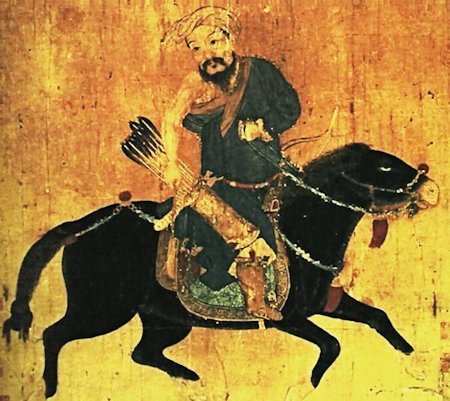
From earliest days rivalry was keen. Although sons aspired to take their father's place in the hierarchy they were required to prove their skill rather than just inheriting it. The ‘Kurultai’ exemplifies this pattern - the chiefs would gather to elect the next leader - the ‘khan’. At this time only the descendents of Genghis were chosen but there was a choice of which one of them to elect. The gathering was a long process and accompanied with feasting, horse-racing and archery competitions.
It was also the brutality of conquest that set the Mongols apart. The historian C.P. Fitzgerald ➚ considered them ‘the most savage and pitiless race known to history’. Certainly they had no qualms about taking a month to systematically butcher a city of a million people but it would appear this was not done with malice. They just felt no empathy with the ‘inferior’ people that they conquered; dispatching them was no different to killing animals. The Khitan adviser Yelü Chucai ➚ (Yelu Ch'u-ts'ai) was strong-willed enough to persuade Genghis Khan not to massacre the entire Chinese population. Yel lived long enough to give the same advice to Kublai Khan when he conquered China.
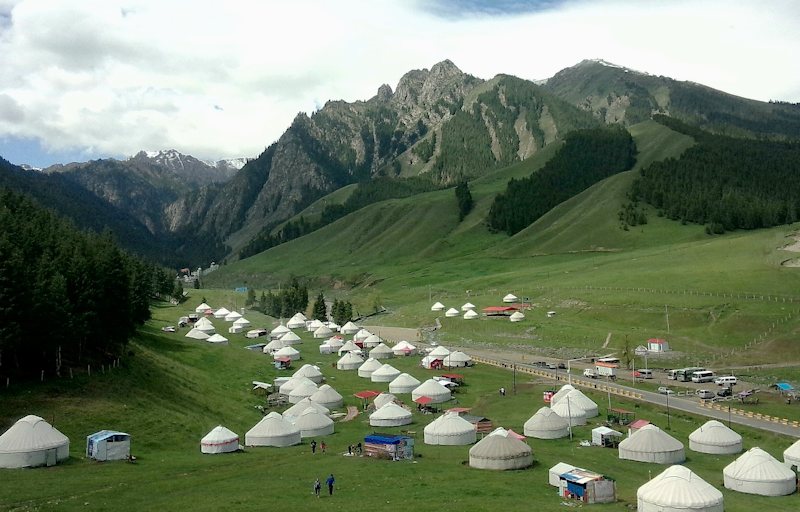
In private life they maintained their own customs. A Mongol could take any number of wives, Genghis is said to have had 500. It was traditional to marry all your father's widows - except your own mother. Mongolian women took an inferior place and never went to battle, their power and influence was in the yurt (ger). Mongols had a rule that they must never wash their bodies ➚ or wash anything in running water. This may seem strange but in the days of infected and parasite-laden water this was a sensible custom. They had a strong addiction to alcohol which remains a problem among present day descendents.
What made them such an unstoppable war machine was not the military tactics themselves but the firm discipline which Genghis instilled. For over a thousand years Mongols had been raiding the Chinese settlements to the south. The Chinese had little defense for a lightning raid by Mongol horsemen. The Mongols learned their tactics from their enemies (Khitans, Chinese) and applied them rigorously. Genghis was successful because he recruited them into strict organized units ➚, separating clan members so that units could not become embroiled in clan rivalry. A legal code was introduced to stop tribal disputes. Genghis introduced an important law that kept his troops from perennial in-fighting. This was that the plunder was to be handed over for the khan to distribute equitably among the troops. This removed a constant cause of unrest in the army. A decimal organization was imposed. Every ten men formed an ‘arban’; ten of these (100 men) a ‘jagun’ or ‘zuun’; ten of these (1,000 men) a ‘minggham’ and ten of these (10,000 men) a ‘tumen’. At each level one person was leader of the other nine. At the arban/jagun the leader was elected while the upper levels were appointed. The Kheshig ➚ formed the elite academy for the khan's bodyguard and top generals called ‘orloks’.
The tumen was regularly drilled in battle maneuvers. In spring time this took the form of a vast hunt encircling hundreds of wild animals. The standard tactic in battle was for the archers to shower an enemy with arrows and then move the light cavalry in. Often a pretended retreat (feint) tempted the enemy into a trap where the heavy cavalry would then move from the rear in the final assault. These were not new tactics, what made the Mongol horde invincible was that they had trained long and hard so that there was no indiscipline or panic.
As time progressed terror became the key weapon. Opponents came to know that any opposition would lead to mass slaughter of all not only the combatants.
Jin Dynasty Conquest 1206-1219
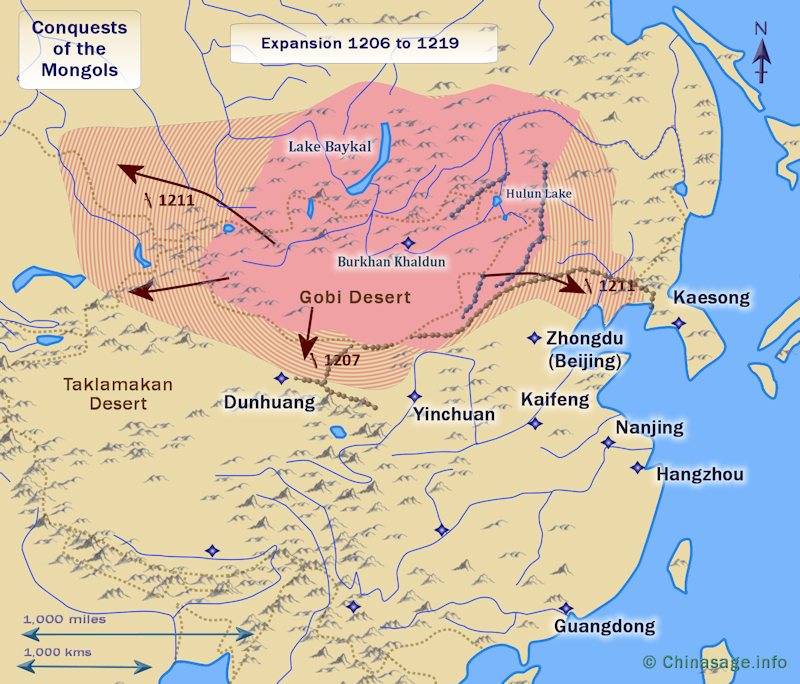
Map of the expansion 1206-19 to take the lands of the Western Xia and Manchuria.
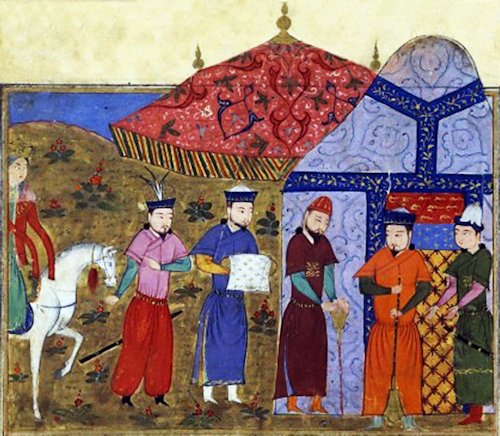
The reason for the appetite for conquest that dominated Mongol thinking has long been debated. One quite recent idea is that climate change ➚ was a pivotal factor. At this time higher rainfall over the northern Gobi desert had increased the availability of pasture land. Grassland is essential for the horses that power the Mongolian war machine. The expansion would also have reduced the travel time over the arid Gobi desert and made journeys of conquest to the south and west practical.
Whatever the reason, in 1206 having unified the Mongols, Genghiz's thoughts turned to the neighboring kingdoms: The Jin dynasty in northern China and the Xixia to his south-west.
The Jin dynasty had started to encroach on Mongol lands. A great wall and ditch and wall was completed 1198, but it was more of a boundary ditch than a wall. The northern wall is named ‘Genghiz Khan wall’ but was in fact built by the Jin to keep out the Mongols. It was 700km long and its western endpoint is near to Temujin's birthplace. The southern wall was only 3 feet [1 m] high and a few meters wide.
Temujin had personal vengeance in mind too, his relative Prince Ambakai (Ambaghai) ➚had been tricked, captured, tortured and executed by the Jin. The Jin, as ever, were more pre-occupied with attacks on the Song empire to their south than small tribes in Mongolia. They often recruited from the Mongolian tribes to fight the Song forces. Temujin realized that the threat of the Xi Xia on the other flank must be dealt with first before taking on the Jin to neutralize a possible joint front against him.

So in 1209 Genghis launched an attack on the Western Xia (which covered present day Ningxia, Gansu and Shaanxi) and by August was besieging their capital at Yinchuan, Ningxia on the Yellow River. The Western Xia pleaded for help from the Jin but the request was ignored. In an effort to break the siege Temujin dammed the Yellow River to try to flood the city. This however led to flooding of the Mongol camp as well. In a rare stalemate the Tangut emperor offered to surrender giving his daughter and offering allegiance to Temujin but fell short of offering him troops.
Temujin (Genghis) was now able to turn his force against the Jin dynasty. The Jin had an impressive force about 500,000 infantry and 150,000 cavalry. Leaving Temüge (Genghis's younger brother) with 20,000, Genghis set off south in 1211 with just 65,000 cavalry. However the Jin were using some Mongolian tribes as mercenaries and their allegiance switched to Genghis at key times. Genghis crossed the Gobi desert and the old Great Wall of China offered little protection. Some of the less heavily defended cities surrendered without a fight. The Jin tactic was not to launch full scale battles in the open but make small raids from the cities that were defended with high walls. At this time the Mongols did not as yet have the siege breaking expertise to attack these fortified city walls. By September 1211 Genghis was at the heavily defended Jin capital of Zhongdu (Beijing) [3]. It had four outlying forts that had been built to attack besiegers from behind. For the moment Genghis retreated ahead of the cold of winter, he was to learn from contacts that the Jin suffered from internal divisions and the Southern Song were still intent on exploiting the position to attack the Jin. So he moved north-east to conquer most of the Jin lands in Manchuria and secured an alliance with the Khitan people ➚ who had been ill-treated by the Jin. The Khitans then attacked and took back Liaoyang (Dongjing), the former Jin capital that had originally been their capital under the Liao dynasty.
In 1212 Genghis was injured and left his son Tolui to continue the attack. Genghis, once healed, rejoined in 1223 and mounted a fresh assault on Zhongdu (Beijing) . This led to some panic and internal in-fighting but instead of attacking the city Genghis took another 90 other major cities in northern China. By this time the Mongols had amassed sufficient expertise to mount attacks on stone city walls. They forced prisoners to build ramparts and tunnels. In an attack the prisoners were forced into the vanguard and took the brunt of the defender's weaponry.
Even though the Jin had access to the latest technology which included flame throwers and catapults they were ineffective against cavalry attacks. When Genghis returned to Zhongdu the four protecting forts were easily captured, the Jin Emperor Xuanzong then capitulated and offered gold, silver and many prisoners. The Mongols took the pick of ‘useful’ prisoners and slaughtered the rest. Emperor Xuanzong of Jin ➚ fled to Kaifeng (and broke his peace treaty) and Zhongdu was surrounded. Meanwhile Subodei (Subutai), Genghis's trusted general, captured much of Manchuria and received the submission of Korea. The situation at Zhongdu was now utterly hopeless and in May 1215 the city surrendered. The mass slaughter and plunder took over a month to complete. A hill was made of the bones of the inhabitants and the great city systematically looted and burnt to the ground. The diminished Jin dynasty lingered on at Kaifeng at the hands of Ogodei before total defeat came in 1233 when both Mongols and Song forces attacked them.
With both the Jin in Manchuria and Xi Xia defeated the whole area descended into chaos. It was the strongest regional power to the west that exploited the weakness. This was the Sultan of Khwarazm ➚ (or Chorasmia) with capital city at Urgench (northern Turkmenistan ➚) who had established a huge empire in Central Asia. He invaded the lands of the Naiman tribe in the west of Mongolia. He made the fatal mistake of underestimating the Mongol leader. The sultan not only rejected the Mongol's request for a treaty to cover trade along the Silk Road but killed the ambassador that brought the proposal.
Kazakhstan Conquest 1219-1223
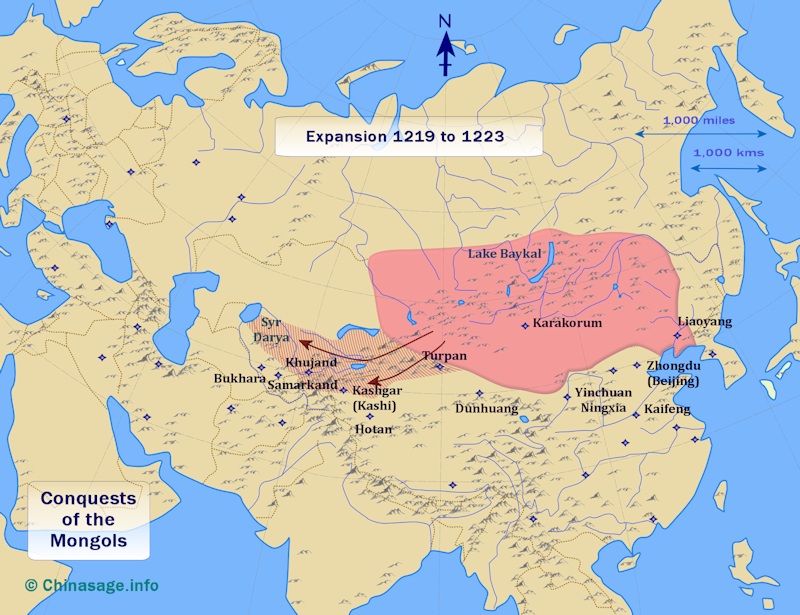
The start of expansion away from Mongolian homeland 1219-23 beginning with the taking of the rich central Asian Muslim kingdom of Khwarazm.

Although this web site covers Chinese history and culture the Mongol conquests elsewhere deeply affected the future of the whole continent. The return of the Mongols to conquer all of southern China came decades after gaining from the experience of destroying cities in central Asia.
The attack on Khwarazm ➚ in 1219 used an enlarged force of 200,000 Mongols split into four groups. By the autumn the city of Otrar was under siege. Many cities fell quickly but Khujand ➚ was stoutly and ingeniously defended. However all were eventually overwhelmed. In a classic tactic Ghenghiz made an ‘impossible’ crossing of the Kyzylkum desert ➚ to launch a surprise attack on Bukhara from the north. Even though Bukhara promptly surrendered it happened to all burn the ground anyway because of an accidental fire.
The Mongols now had control of central Asia - from the Caspian Sea to the shores of the Pacific. News of a vast army in the east even reached the ears of Pope Honorius III ➚ in Rome who thought that this army must surely be the forces of Prester John ➚, a legendary Christian king. Perhaps Genghis's Christian connections (adopted son of a Christian king) led to this garbled account. In 1221 these rumors encouraged western Europe to launch an unsuccessful crusade ➚ into Syria.
Further Conquests 1223-1227
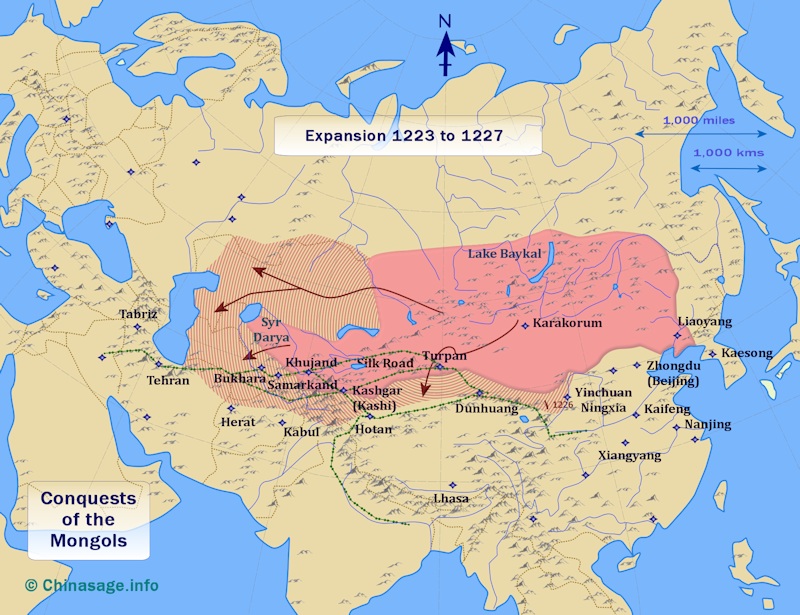
Map of expansion of the Mongol empire 1223-27. Much of the expansion was along the Silk Road route eastward but also into southern Russia.
With the fall of Khwarazm the roads to further conquests to the west were now open. In 1223 there were raids as far as the lands between the Black and Caspian Seas including Georgia but the lands were not conquered. The whole Silk Road from Tehran to Dunhuang fell under Mongol control. Genghis left the campaigns to his generals and returned home. Genghis refused to become a pampered autocrat living in great luxury in a palace, he remained true to his origins, preferring life in the saddle and enjoying the thrill of the chase.
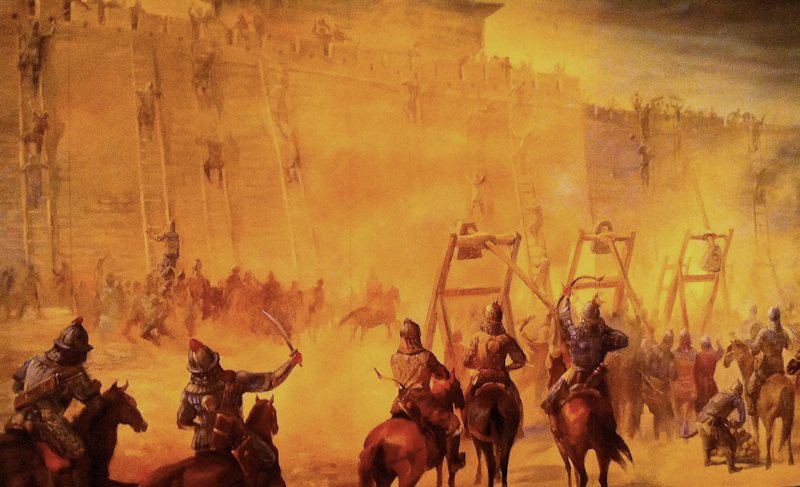
The Tangut kingdom of Xi Xia had made an alliance with Genghis in 1209 but they had failed to provide the required forces for his campaigns. They now unwisely rebelled against their tutelage. Genghis led what was to be his last campaign in 1225. Once again he built dams on the Yellow River to enable them to starve out or flood the beleaguered capital of Yinchuan. Genghis fell ill in 1226 and died on August 18th 1227, may be from illness or accidental injury - nobody knows. After his death the Tanguts were annihilated - everyone: men, women and children. Only 1% of the population managed to escape. The whole Tangut culture disappeared and their written language has only recently been deciphered.
Genghis's coffin was carried slowly back to his birthplace at Burkhan Kaldun and he was buried in a small unmarked grave. It is said that anyone unlucky enough to see the cortege was instantly killed in order to keep the death secret from the many rival successors. It was some years later that his grave was acknowledged with a sacrifice of horses and virgin girls. History records him as the epitome of merciless butchery but he was certainly a more complicated person living by his own moral standards where loyalty, truth and fairness held high esteem.
Genghis's heirs 1227-37
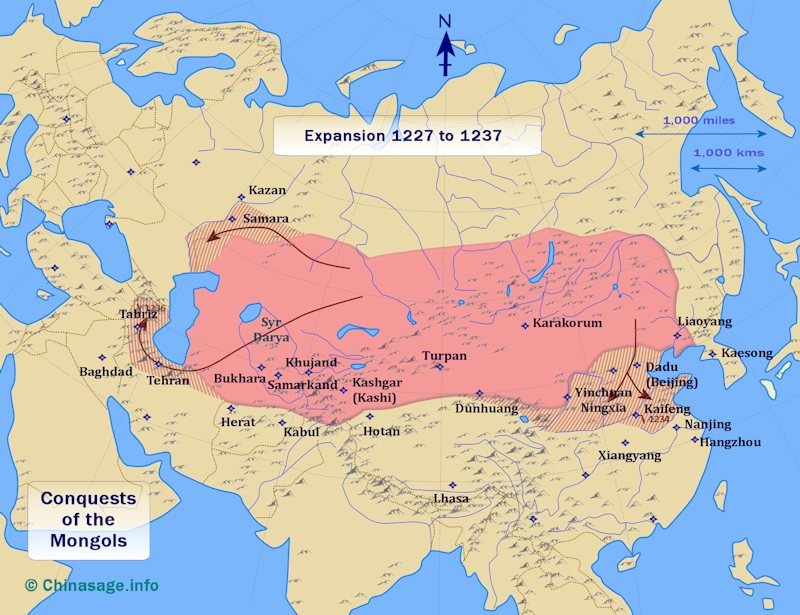
Map of Mongol expansion 1227-37 which included conquest of northern China northern Persia and southern Russia.

After a brief lull in hostilities, Genghis's son Ogedei ➚ (Ogodei) was enthroned as Khagan in 1229 and the conquests began afresh. In 1230 Ogedei resumed the attack on Jin forces in present day Shanxi province. With assistance from Southern Song dynasty forces the remnant Jin forces centered at Kaifeng were besieged in 1232. Ogedei then left the final conquest to his generals which was completed 1234. Ögedei relaxed the harshest of Genghiz's laws; so when Kaifeng fell in 1233 the lives of the millions of inhabitants were spared.
By this time the Mongols had honed their strategies for taking heavily defended walled cities. Firstly they offered to spare lives if the city capitulated without a single shot being fired. If they did not all the inhabitants would be massacred. It was a persuasive threat as the defenders knew it was not an idle one. The Mongols captured men from the surrounding countryside and then forced them to lead the attack against the city, so the defenders had no choice but to kill their own people.
The Song forces then captured Kaifeng, Luoyang, and Chang'an from the defeated Jin but made the mistake of murdering a Mongol ambassador - just the sort of grievance that added pressure for revenge. So in 1234 Ogedei announced plans to attack Korea, southern China and southern Russia all justified by the murder of Mongol envoys.
In 1235 Karakoram was made the capital of Mongolia and in 1236 Ogedei Khan began his campaign of conquests with an attack on Georgia and Armenia.
At the Gates of Europe 1237-59
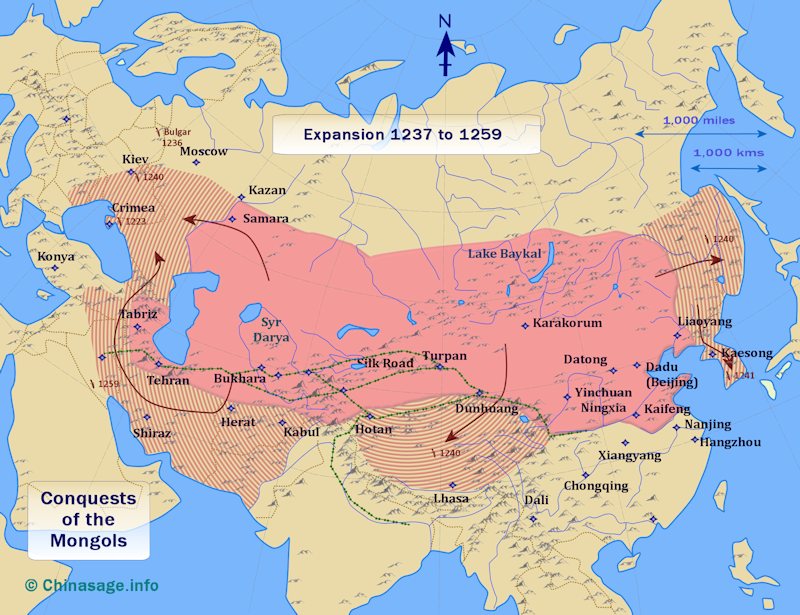
Map of further Mongol conquests 1237-59 that brought them to the gates of Europe. Tibet, Korea and Persia were all conquered. The whole Silk Road from China to Baghdad was under their control.
Ogedei pursued his attack on Korea in 1238 and this led to surrender of the whole Korean peninsula in 1241. Meanwhile Ögedei's son Khuden led the conquest of Tibet in 1240. His nephew Batu Khan ➚ continued to expand the conquest into southern Russia 1238-1240 taking them to the gates of the Ukrainian city of Kyiv.
Batu and Subutai took the grasslands of Hungary and made plans to conquer Italy, Austria and Germany. But in December 1241 the great Khan Ogedei died and all the Mongol leaders withdrew to hold the Kurultai ➚ to elect his successor at their homeland capital of Karakoram.
Meanwhile Batu consolidated control over western Russia. Tolui's son Möng/Mongke became the Great Khan or Khagan in 1251 and he vowed to follow his grandfather's vision of a worldwide empire.

Kublai's conquest of China 1259-79
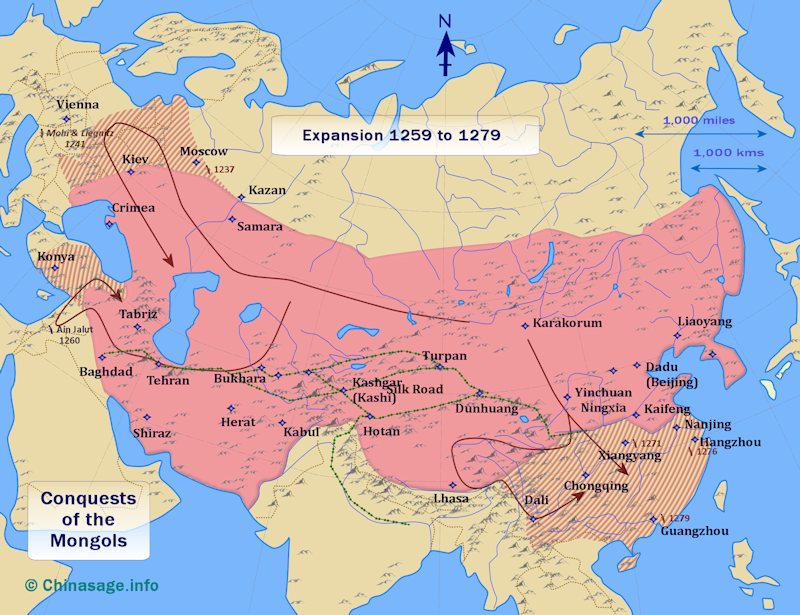
Conquest of the Southern Song 1264-79 and important defeat in Palestine by the Egyptian Muslims at Ain Jalut.
The Mongolian horde met its match at Ain Jalut ➚ (between Acre ➚ and Jerusalem) in 1260. The battle took place between the Egyptian Mamluk Sultans and the Mongol horde on 3 September 1260. The Mongol defeat is considered the turning point in the campaign of conquest but this was more to do with the shortage of pasture land for the thousands of Mongol horses in arid Palestine than the capabilities of the army.
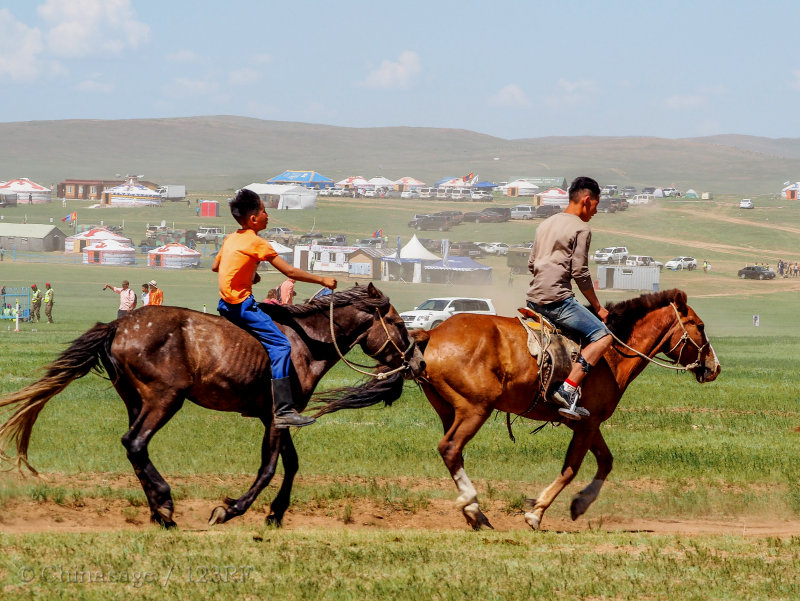
On Mongke's death in 1259 the Mongols fell into a civil war over the succession ➚ to be Great Khan (1259-64) between his two brothers Kublai and Ariq. This diverted forces away from further expansion into Europe and Egypt.
Kublai had become fascinated by Chinese culture and its vast riches. It remained the richest and most populous country on Earth. The remaining southern Song lands were still the most culturally developed in the world, quite a contrast to the empty lands of southern Russia. The Southern Song dynasty based at Hangzhou felt themselves safe beyond the natural defenses of mountains and rivers. Although invincible on open plains the Mongol horsemen could not so easily launch attacks over the steep mountains and the wide rivers of central and southern China. The defeat of their foes, the Jurchen (Jin), in northern China did not seem necessarily a bad thing to the Song people. Indeed the Mongol invasion had given the opportunity for the Song to briefly retake land in the north.
The Mongols began an encircling movement to the west by capturing the modern provinces of Yunnan and Sichuan. The Chinese military system, little changed since the Qin dynasty was ineffective. Armies were raised on demand from the peasantry when needed, there was no permanent professional army. No city managed to hold out for very long. The whole population of the city of Changzhou, Jiangsu, over a million people, were slaughtered in 1275. Many other Chinese cities shared the same fate.
A lesson taken from the conquest of divided Jin and Song China led to the strong belief that a divided China could not effectively defend itself, the integrity of the nation's heartlands has been maintained from the Yuan dynasty to the present day.
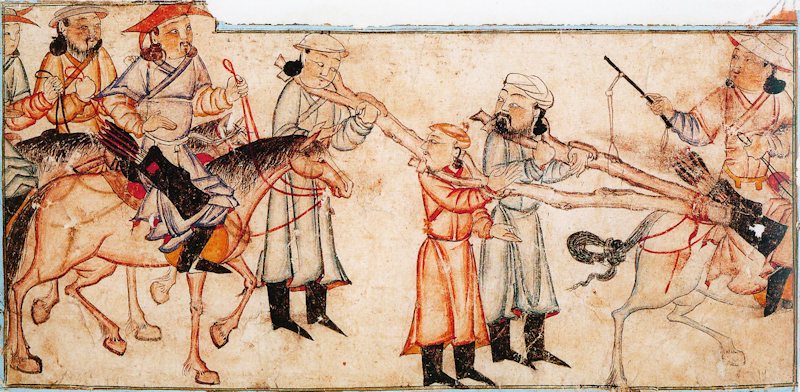
Pax Mongolica 1279-1300
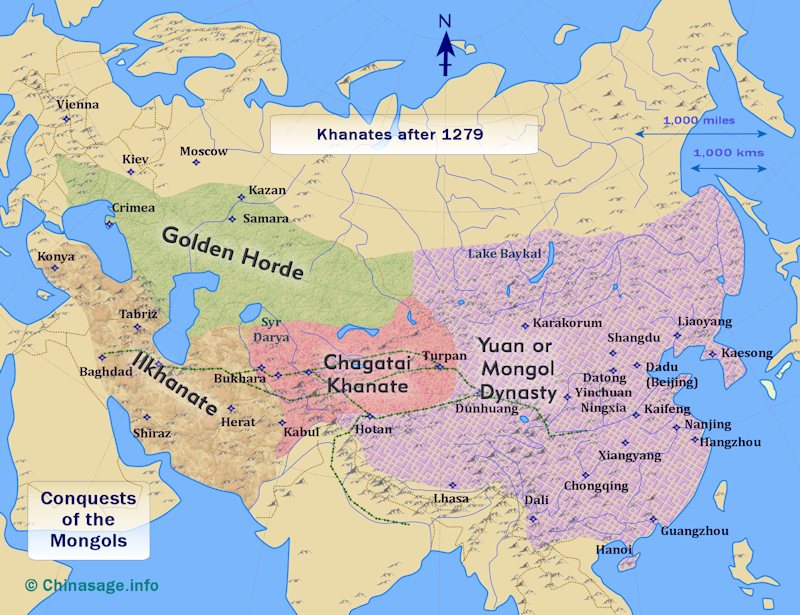
The four Khanates that form the Mongol Empire. The Great Khan found it impossible to rule the whole empire as a single entity.


Kublai was victorious in China but he was never recognized as the ‘Great Khan’ by the western khanates. The khans in the west adopted Islam as their religion in line with their citizens but Kublai under the strong influence of his wife Chabi ➚ adopted Buddhism. Buddhism and Islam are pretty much incompatible and it was inconceivable that either side would accept the leadership of the other so the Mongol empire became divided between four great khanates: The Golden Horde (southern Russia; Kazakhstan); Chagatai Khanate (centered on Kyrgyzstan); Ilkhanate (centered on Iran) and the Great Khan's Yuan Dynasty in China. It's quite remarkable that the heirs of Genghis did not fight among themselves for supremacy. Perhaps the allure of the simple life on the grasslands was fading for them, supporting the notion that those conquered on horseback can't be ruled from horseback.
The descendents of Jochi were to rule Russia for 100 years as the Golden Horde. In Persia (Iran) Hulegu (one of Tolui’s sons) was first of seven Il-khans to rule for nearly as long. In the south Babur ➚, a Mongol, founded the Mughal Indian dynasty in 1526 which lasted for 330 years.
Many Mongols later aspired to recreate the ‘glories’ of Genghis’s conquests of Asia. Timur or Tamerlane ➚ (1336-1405) came closest to achieving this. Although not a direct descendent of Genghis he adopted many of his tactics. He succeeded in building an empire in central Asia - roughly the area of the Ilkhanate. He planned to conquer China and Europe but died before the conquest could begin.
It was during this time that peace and stability allowed people to travel without difficulty. The vast distances of the khanates were criss-crossed with staging posts. Fast riders could bring news to the commanders very rapidly. Priority was given to keep the roads passable and free of bandits. It was Marco Polo who became the most famous beneficiary of the Pax Mongolica.
One of the lasting impacts of the Mongol conquest was in central Asia; with millions dead vast tracts of farmland reverted to wild steppe. Many cities were destroyed and never rebuilt. The turmoil moved the center of civilization away from central Asia towards the south and west. It is strange how such a brutal episode holds more interest than many comparable achievements. Statues and memorials of Genghis litter Mongolia, he is a figure still proudly acclaimed despite all the brutal slaughter. For the millions who died it was an unmitigated disaster. If the Mongols had succeeding in conquering Europe it may well have instigated a new Dark Age ➚ setting back the progress of civilization.
In China the history of the Yuan or Mongol dynasty is described in a separate section on this web site. As far as ordinary Chinese were concerned the Mongol rulers brought about remarkably little change and were soon gone.
Notes
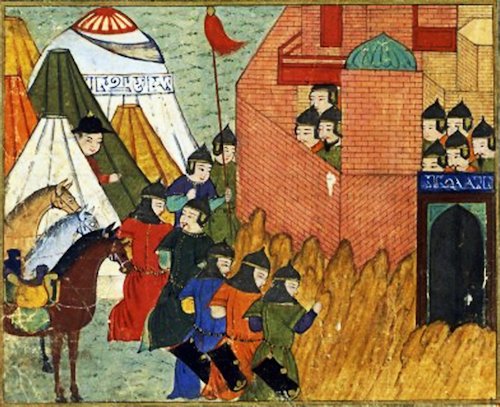
[1] Why?
I wrote this piece after reading James Chambers's book on Genghis Khan and becoming confused as to where the events took place - it has no maps. I also watched a DVD Genghis: The Legend of the Ten ➚ (2012) which gave some fresh insights into how the Mongol army operated. I thought I'd create a page with maps showing the progress of the Mongol Quest. This proved more difficult than expected partly because contemporary records are so thin on the ground.
[2] Names
Nearly all the names have at least one alternative spelling. For example Genghis/Genghiz/Djingis. This is because Mongolian is like Chinese - hard to transcribe into English sounds. I have used the most widely used form even if that is not strictly correct.
[3] Place names
Just like personal names the names of places has changed over the centuries. Some are a matter of an alternative spelling, is it Irbil, Arbil or Erbil? While other places particularly in China have been renamed. Beijing is on the site of the cities of Dadu and Zhongdu, while Hangzhou was at the time known as Lin'an. To make things easier for you, I have chosen the present day names as much as possible. Doing this helps to at least anchor locations in the mind.